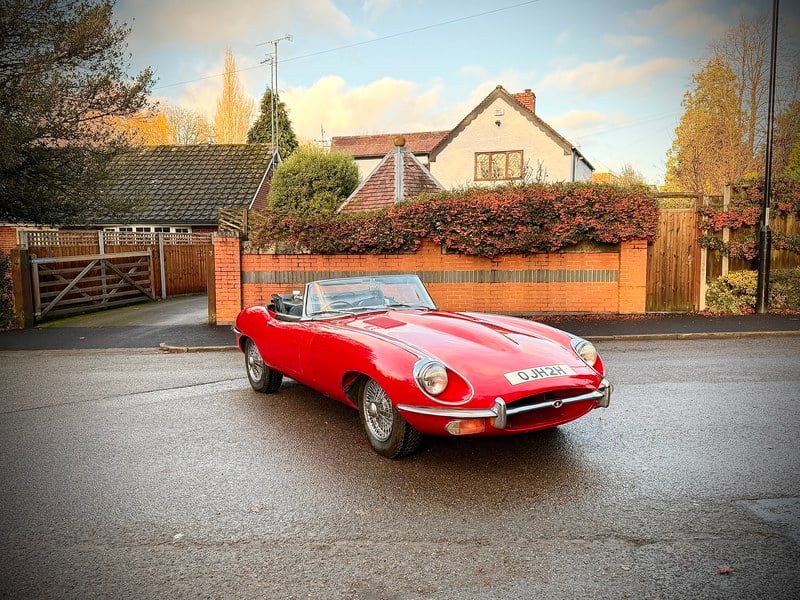Description
Price Reduced
1954 Jaguar XK 120 drophead coupé
First owned by French singer Gilbert Bécaud
Comprehensive body restoration to a high standard
Recent engine rebuild
Coopercraft disc brakes and five-speed gearbox
Toulon-born singer Gilbert Bécaud would have cut quite a dash in 1950s France at the wheel of his newly acquired Jaguar XK 120 drophead coupé. Having been part of the Resistance during World War Two, Bécaud became a songwriter in 1948 and started singing himself a few years later following encouragement from Edith Piaf. He was still in his 20s when he bought this XK 120 – which is now being offered for sale at the Classic Motor Hub – and it would have been the perfect choice for the stylish young performer.
Chassis number 678351 was dispatched from the Browns Lane factory in Coventry on 27 May 1954, and sold new to Bécaud via Parisian distributor Charles Delecroix. It was delivered in Pastel Blue with a blue interior, and the accompanying Heritage Certificate states that it was fitted with engine number F3194-8, body number P2616 and gearbox number JL23094.
As the 1950s progressed, Bécaud began acting and an English version of his song Je t’appartiens became a hit for the Everly Brothers. It would later be covered by the likes of Bob Dylan, Elvis Presley and Nina Simone, while another song of his, Et Maintenant, was recorded under the title What Now My Love by Shirley Bassey, Judy Garland and Frank Sinatra.
The XK 120 was first registered in the UK in 1989. It was imported after being acquired by Trevor Scott-Worthington, who was ‘Total Quality Manager’ for Jaguar at the time, and kept the car for 19 years. Mr. Scott-Worthington had also set up Jaguar spares specialist Coventry Auto Components in 1969.
Although the car was still attractive and driving well by 2016, the then- owner decided to commission a full restoration.
The work was carried out by Clanfield Coachbuilding in Oxfordshire. The bodywork was stripped to bare metal and any repair sections were finished with traditional lead-loading – as would have been done at the factory. A full engine rebuild was carried out and a new clutch assembly fitted, while a specialist ash framer replaced any woodwork that was showing signs of deterioration.
Inside, the seats were in good condition and had acquired a nice patina, so the decision was taken to leave them as they were. The rest of the interior was retrimmed, including new carpets and door cards, and the rare ivory steering wheel was retained as a nice touch of European chic from the car’s time in France.
The restoration process took five years, and a full photographic record is part of the history file. Coopercraft front disc brakes and a five-speed gearbox are both popular modifications that make the XK 120 a much more useable proposition in modern conditions, and this drophead coupé is now ready to be enjoyed by its next owner.
MODEL HISTORY
The Jaguar XK 120 was the sensation of the 1948 Earls Court Motor Show. The lithe sports car was initially intended as a low-volume showcase for Jaguar’s brand-new, 3. 4-litre, straight-six engine – descendants of which would survive into the 1990s – but it was soon being put into production.
Demand far exceeded the expectations of Jaguar boss William Lyons, and the XK 120’s blend of beauty and performance – it was the world’s fastest production car when it was launched – made it an international sales success at a time when exports were vital to British companies.
Three body styles were produced before the XK 120 was replaced in 1954 by the XK 140. First came the Open Two-Seater (also known as the Roadster), which was followed in 1951 by the fixed-head coupé, and in 1953 by the drophead coupé. At first, the bodywork was constructed from aluminium, but in early 1950 Jaguar instead began to use steel for most sections.
Although the standard XK 120 produced 160bhp, the SE model upped that to 180bhp. Fitting a C-type head plus larger 2in SU carburettors boosted it even further to 210bhp, and it’s little wonder that XK 120s proved to be so successful in competition.
At the 1950 Le Mans 24 Hours, the car of Leslie Johnson and Bert Hadley was a late retirement from third position, but their performance helped inspire Jaguar to return in 1951 as a works team with the C-type. This time they won outright, the first of five Jaguar victories at La Sarthe during the 1950s.
There was rally success, too – most famously courtesy of Ian Appleyard in ‘NUB 120’ – plus record runs that included averaging 100. 31mph for seven days and seven nights at Montlhéry in 1952.
Although the XK series lived on until the XK 150 was replaced by the E-type in 1961, for many enthusiasts the original XK 120 was the purest example of the breed, and it’s little wonder that, seven decades later, it remains such a coveted sports car.

























